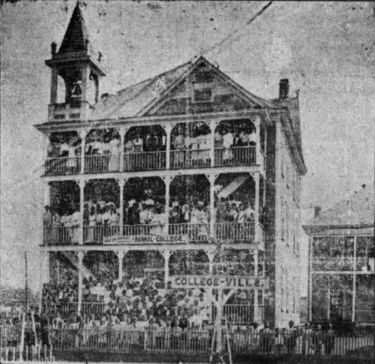Lauderdale College
Lauderdale College was a school founded by W. L. Lauderdale through his insurance business, the Great Southern Home Industrial Association. The other incorporators of the school, who became its board of trustees, were William Pettiford, Ulysses Mason, E. D. Coleman, and B. H. Hudson.
A full scholarship for tuition was given to students whose family all took out insurance policies with the company. The basis of instruction was the industrial arts, with classes available in business management and literature. Though not affiliated with a particular denomination, the college strongly promoted Christian precepts of, "good morals and strong character."
The college, erected at a cost of $75,000, occupied a three-story building near the corner of 27th Court and 34th Place North in the North Birmingham neighborhood which came to be called Collegeville. Another two-story frame building served as a chapel and girls' dormitory. Several nearby cottages were also used, for a dining hall, a commissary, and as residences for teachers and students.
The first class of 250 students was admitted on February 22, 1904. The classes in millinery arts, cooking and drawing won prizes at the 1904 Alabama State Fair.
In April 1905 the school hosted the inaugural meeting of the Collegeville Citizens' Conference, modeled after a similar program at Tuskegee. Principal Elisha Jones was made president of the Conference's board of directors.
For the 1905 academic year, which began in September, it had an enrollment of more than 750 students. Judge N. B. Feagin addressed the assembly at the beginning of the term. That fall Lauderdale also fielded a football team.
The school was destroyed in a fire, blamed on a defective flue, on the evening of December 10, 1905. It was reported early on that the school would rebuild on the same site, expanding to 40 acres with a capacity for an enrollment of 2,000 students. The first new buildings were projected to cost $100,000.
In the event, Lauderdale did not rebuild the school, but did continue his other businesses, including the Peoples' Investment and Banking Company.
References
- "Articles of Incorporation" (March 16, 1905) The Birmingham News, p. 13
- "Negro Conference Organized at North Birmingham" (April 8, 1905) The Birmingham News, p. 23
- "Lauderdale College Opened Yesterday" (September 5, 1905) The Birmingham News, p. 10
- "Lauderdale School At Birmingham For The Education Of The Colored Youth." (November 11, 1905) The Montgomery Times, p. 9
- "Lauderdale College Burned to the Ground" (December 11, 1905), Birmingham Age-Herald, p. 5
- "Lauderdale College Will Be Enlarged" (December 22, 1905) The Birmingham News, p. 3
- "Lauderdale College Trustees Ask for Donations" (February 2, 1906) The Birmingham News, p. 13
- "Lauderdale College Will Be Rebuilt on Same Site" (March 19, 1906) The Birmingham News, p. 24
- "Dr. W. L. Lauderdale" (January 1, 1910) The Birmingham News, p. 5
